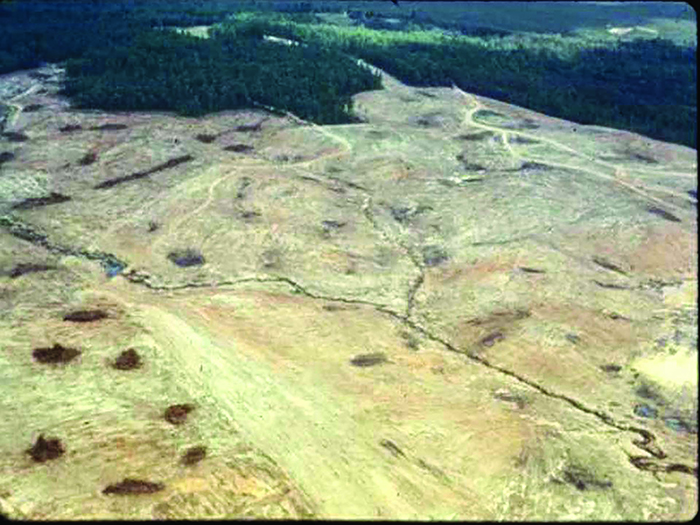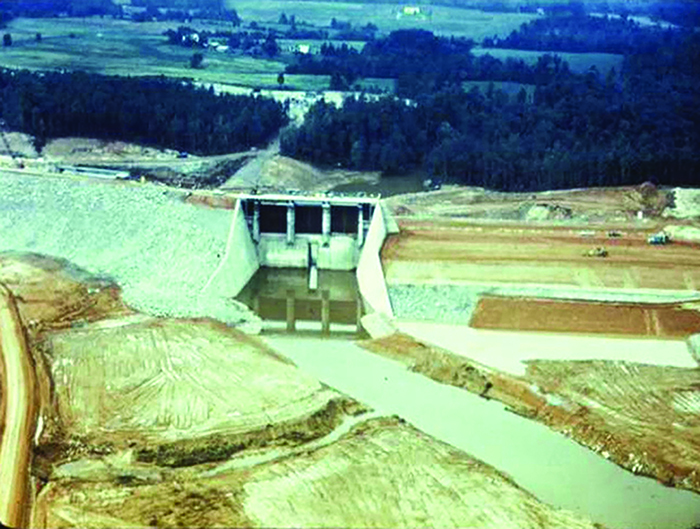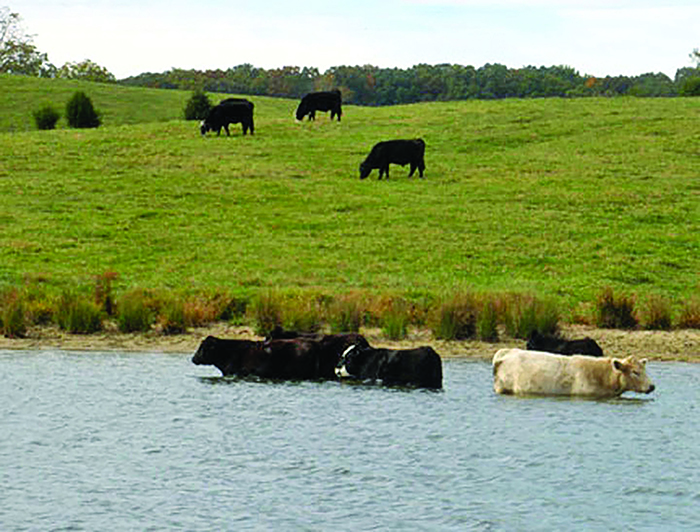Lake Anna’s First 50 Years
by Linda Salisbury

Land is cleared to prepare for damming the North Anna River to create Lake Anna (photo courtesy of Dominion Energy).
Well, happy birthday, Lake Anna!
Even though this celebration is for you, you are a gift that keeps on giving to the rest of us.
Fifty years ago, the Virginia Electric and Power Company (VEPCO, now Dominion Energy) created a 17-mile lake in Central Virginia. Although the purpose was to serve the power company, Lake Anna has evolved into a hub of recreational activity with its boating, swimming, camping, fishing, hiking, restaurants, brewery, cidery, vineyards, state park, and respite from urban life.
Its use for generating regional nuclear power, recreation, and housing has changed the landscape dramatically as “old-timers” can attest.
More than five decades ago, land was cleared for the lake’s construction. This area had been used primarily for farming and timberlands, with roads directly connecting the counties. After the lake’s creation, those roads no longer existed, which created a much longer drive through the region.
Many landowner families dated back to the Revolutionary and Civil War eras. The North Anna River, fed by generous tributaries where miners found gold and minerals, flowed through the area. VEPCO saw this as the perfect location for a nuclear plant, with the dammed river creating a reservoir to provide a cooling pond.
The lake project started in the late 1960s. The land was cleared of 13,000 acres of farms, roads, buildings, and timber starting in 1968 to create the reservoir. Residents watched as the 90-foot high dam was constructed to block the flow of the North Anna River to provide water for the power station.
VEPCO anticipated that it would take three years to fill the new lake, one of the largest in the state. But instead, Hurricane Agnes did the job in eighteen months. The dam was completed in 1972, and the first of two nuclear reactors went into operation in 1978. With the filling of the reservoir, opportunities soared for development.
Ken Holt, spokesperson for Dominium Energy, explained that three dikes separate the two sides of lake. The warm (or private) side has no public access, and the cool side has access to the public. The warm side serves as the cooling pond with three lagoons to cool the water from the plant before it returns to the main lake near the dam.
As it cools, the water in the warm side can be about fourteen degrees warmer than usual, which is a pleasant condition during colder seasons. But as the warmer water that has passed through the lagoons reenters the cold side, it’s only a few degrees warmer.

The two open circles represent emancipation and the breaking from the shackles of slavery. The memorial is located in a field that enslaved laborers used to work (photo by Olivia Bridges).

Ken Holt is the spokesperson for Dominion Energy (photo courtesy of Dominion Energy).
Holt said that shortly after the plant began operation, the lake was with stocked with bass, trout, sunfish, stripers, and channel catfish among other varieties. Sterile carp were used later to control an invasive hydrilla problem. Fishing is popular by boat or on land, and there are annual tournaments for adults and children.
Doug Whitlock, vice president of Lake Anna Land Corporation (founded in 1976), was among the locals who watched the lake fill. A native of Louisa, Whitlock and his family have owned property in Lousia County in the vicinity of Wares Crossroads since before the Civil War. Dickinson’s Store is now easily recognized at this location.
After the lake was filled, Whitlock’s father created the first development on the warm side: the 90-lot Aspen Cove. Whitlock said that initially, like most early developments, the lots were used for camping, mostly by RVs. Whitlock’s company has since developed 27 subdivisions at the lake, continuing the mostly family-owned business for almost 50 years.
Although newcomers and visitors now vastly outnumber pre-lakers, those living in the area when the lake was created have stories to share. Louisa native Irene (Duerson) Luck has many memories of before and after the lake’s creation.
Luck’s grandfather, Virgil Duerson, purchased his land – including what is now the Bear Castle subdivision – in about 1870. When Luck was about ten, her father, James Duerson, sold about two-thirds of the farmland to VEPCO for the development of the lake.
(As a historical footnote, Bear Castle enjoys a connection to Thomas Jefferson, whose sister Martha married Dabney Carr, one of Jefferson’s childhood friends. Carr’s birthplace, Bear Castle, still stands in the subdivision bearing its name.)
Luck grew up playing on her dad’s dairy farm off Kentucky Springs Road and watched the development of the lake from the family’s property. After the lake was created, her family had waterfront property and enjoyed recreational opportunities such as boating. She also enjoyed the change from “swimming in a small pond (a farm pond) to swimming in a big pond.”
Like Whitlock, Luck remembers the area surrounding the new lake developing into subdivisions. Many lots were used by people from Richmond and Charlottesville, including doctors and sports figures who enjoyed camping at the new lake.
With land use changing from agricultural, her father was among those who found new careers. Luck’s dad turned from dairy farming to custom home building as a class-A contractor. Subsequently, he built 75 homes at the lake and taught basic building skills.

Cattle, one source of water pollution, wade in the rivers near Lake Anna. Many farmers are working to fence them off from entering the water (photo by Linda Salisbury).

A Lake Anna State Park visitor from Maryland enjoys the lake with her dogs while spending a weekend in one of the park’s waterfront cabins (photo by Linda Salisbury).
Luck’s lifelong love of the Louisa area and the lake brought her back to the area after college. Besides raising her family, she pursued a career in journalism and volunteerism.. One of her most dedicated activities is serving on the board of the Lake Anna Civic Association (LACA).
This organization’s mission is to protect, conserve, and preserve the lake. Its activities include monitoring water quality in conjunction with the power plant and the Department of Environment Quality. Members also study new developments planned for the lake and at times take positions to oppose actions they feel are harmful to the health and quality of the lake.
The Lake Anna Business Partnership is another organization serving the lake area as members from local businesses, the community, and civic organizations meet monthly to network, discuss, and support issues affecting the three-county area. In recent years they have discussed the need for a medical facility and broadband internet.
A highlight of the Lake Anna area is Lake Anna State Park, with ten miles of lake frontage. Regional visitors and locals enjoy its cabins, yurts, lodges, tent sites, trails for hikers and horseback riding, a large beach, fishing, boating, canoeing, and accommodations for people with various disabilities.
There are also nature programs, a boat ramp, and a look into its land’s historic features, including the site of the former Goodwin gold mine. The park offers tours of the former mine site and an opportunity for children to experience panning for gold. The park’s facilities have also been a perfect location for festivals and charitable events, and even large baptisms in the lake.
Dominion Energy has provided other economic benefits to the lake area, especially to Louisa County, which received about $13 million in taxes in 2020. Holt said that the normal workforce of 900 at the plant doubles during refueling outages when the reactors are shutdown, refueled, and maintained.
Each reactor operates for 18 months before needing to refuel. The outages last about 30 days as fuel is replaced and the specialized traveling workers do maintenance and install improvements. Workers rent rooms, homes or motels and eat in local restaurants, providing an economic boost to businesses and rental property owners.
Dominion Energy has also been generous in its support of community projects, donating more than $206,000 to groups in the three counties surrounding the lake, including fire companies and food banks. Dominion Energy employees also volunteer for community projects such as road cleanup, and one employee volunteered during the pandemic in 2020 to take senior pictures of 350 students.
As Lake Anna moves into its next 50 years and beyond, may it continue to provide power to the region, clean water, and appreciation and protection by those who enjoy its many opportunities.
So happy birthday, dear lake, and many more!

